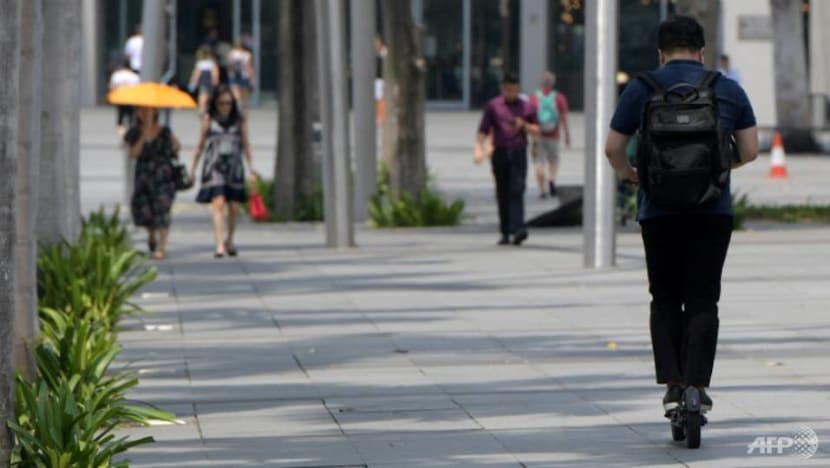PMD numbers set to plunge, but devices can still play a role in urban transport, say experts

An e-scooter rider in Singapore. (File photo: TODAY)
SINGAPORE: Following a boom in their popularity in recent years, the number of personal mobility devices (PMD) such as e-scooters looks set to plunge in the coming year with the deadlines for several schemes affecting their use either ending or kicking in at the end of this month.
As of Dec 17, the Land Transport Authority (LTA) said it had received 23,500 applications under the early disposal incentive scheme for e-scooters which do not meet the UL2272 fire certification standard.
Next Tuesday (Dec 31) marks the end of the scheme, which provides a S$100 incentive to those who dispose of their registered e-scooters at one of about 200 locations islandwide.
The devices are recycled for their parts.
This comes amid an increasing number of fires involving PMDs, with 73 such cases between January and September this year, resulting in 36 people injured and one dead.
READ: S$100 'early disposal incentive' for e-scooters that do not meet fire safety standards: LTA
READ: Fires involving PMDs hit record high; 73 from January to September this year
Meanwhile, the LTA’s e-scooter trade-in grant – which allows delivery riders from Deliveroo, Foodpanda and GrabFood to trade-in their e-scooters for e-bikes or bicycles – will also come to an end on Dec 31.
More than 3,000 riders from the three main food delivery outfits here have applied for the grant, with more than 90 per cent of applications approved.
Taken together, both measures will see about 27,000 e-scooters taken off the streets here – more than a quarter of the roughly 100,000 registered e-scooters here.
The trade-in grant followed a ban on the use of e-scooters on footpaths, which came into effect on Nov 5.
Next Tuesday also marks the end of the "advisory period" for the ban on the use of e-scooters on footpaths, where those found riding them on footpaths are issued warnings.
More than 3,400 such warnings were issued by the LTA in the first month of the footpath ban.
From Jan 1, a "zero-tolerance" approach will be taken and e-scooter users found riding their devices on public footpaths can be fined up to S$2,000 or jailed for up to three months, or both.
Other types of PMDs such as hoverboards and electric unicycles are also expected to be included in the ban by next year.
The devices can still be used on the more than 440km of cycling paths around the island, though this is a significant decrease from the 5,500km of footpaths available to riders previously.
The ban followed the death of 65-year-old Madam Ong Bee Eng, who died in September after getting hit by a PMD rider while on her bicycle, sparking anger and concern among pedestrians with many turning to social media to express their feelings.
Last month 20-year-old permanent resident Hung Kee Boon was charged with causing her death. He was also handed two other charges of riding an unregistered and non-compliant device under the Active Mobility Act.
READ: PMD retailers worried about impact of footpath ban that came 'without warning'
READ: Demand for e-bikes expected to increase, but retailers taking it slow
PMDS CAN STILL PLAY A ROLE IN URBAN TRANSPORT
These developments have dented the popularity of PMDs, said Denis Koh, who chairs local PMD enthusiast group Big Wheel Scooters Singapore.
The footpath ban in particular has dealt a “deadly blow” to users here, he said adding that it disrupts the connectivity required to make PMDs a viable mode of transportation.
Further regulatory requirements next year, such as mandatory inspections, are also likely to hamper their use, he added.
But Singapore University of Technology and Design (SUTD) researcher Julienne Chen said the ban on the use of e-scooters on footpaths was appropriate.
“PMDs and pedestrians travel at very different speeds, and do not belong on the same path. This has been clearly illustrated through the well documented conflicts between them,” said Ms Chen, who is a research fellow at SUTD’s Lee Kuan Yew Centre for Innovative Cities.
Still, such devices have a role in urban transportation, noted Singapore University of Social Sciences (SUSS) transport expert Walter Theseira.
“Private car transport, even if it is autonomous or electrified, simply uses too much road space and energy for short distance travel. Current forms of public transport, such as buses or rail, are cost ineffective when passenger loads are low,” he said.
In contrast, PMDs use little energy and provide “sufficient speed and flexibility” for short commutes, noted Associate Professor Theseira, who heads the master of urban transport management programme at SUSS.
The popularity of PMDs as well as dockless bike-sharing, points to a “very clear demand” for different ways of getting around the city, said Ms Chen.

BUILDING INFRASTRUCTURE FOR PMDS NOT AN "INSURMOUNTABLE CHALLENGE"
Mr Koh - who sits on the Active Mobility Advisory Panel - said by not imposing an outright ban on PMDs, the authorities are giving a clear sign that they are trying to find the “right balance” in accommodating all users.
Senior Minister of State for Transport Lam Pin Min recently announced that the expansion of Singapore’s cycling paths – set to grow to 1,300km by 2030 – could be expedited.
READ: Plans to triple Singapore's cycling network may be sped up 'a couple of years': Lam Pin Min
This is a welcome announcement for PMD users, said Mr Koh, adding he hoped all footpaths wider than 2.5m could be reclassified as shared paths to allow for the responsible use of e-scooters.
“It’s common for people to say that Singapore is a land scarce country, and therefore does not have room for bicycle or PMD infrastructure,” said Ms Chen, noting this is a problem found in most cities.
Still, this is not an insurmountable issue with some engineering and design creativity, she said.
“For instance, decreasing the width of car lanes can free up the extra space needed for bicycle lanes without widening the overall road. It requires some creativity and innovation to conventional models of traffic engineering.”
However in certain areas – such as private housing estates - tweaking the infrastructure in such a way may not be possible, said Associate Professor Theseira.
“The right solution there might be to allow PMDs onto local roads.”
Mr Koh said there needs to be greater education efforts to ensure PMD riders are more civic-minded.
“We can have first world infrastructure but we also need the right attitude to pull this off,” he said, adding a mix of “social etiquette, infrastructure and enforcement” are needed.
Still, the fear of yet more rules on their use may prevent many from riding their PMDs again, said Associate Professor Theseira.
He pointed out that many users were caught off guard by the adoption of the UL2272 fire safety standard after having already bought PMDs before the requirement was introduced.
“I think if we are to have PMDs come back into use, we should have a more carefully constructed regulatory framework, particularly in terms of PMD construction standards and licensing, so that users can make any purchasing decisions without risk of being caught out.”














